Abstract
Objectives
To determine the risk of intrapartum stillbirth among teen mothers.
Methods
The Missouri maternally linked data containing births from 1978 to 1997 were analyzed. The study group (teen mothers) was sub-divided into younger (<15 years) and older (15–19 years) teenagers. Women aged 20–24 were the referent category. We used Kaplan–Meier product-limit estimator to calculate the cumulative probability of death for each group and the Cox Proportional Hazards Regression models to obtain adjusted hazards ratios.
Results
The rate of antepartum and intrapartum stillbirth among teenagers was 3.8 per 1,000 and 1.0 per 1,000, respectively, compared to 3.5 per 1,000 and 0.8 per 1,000 among the reference group. The adjusted risk of intrapartum stillbirth was more than 4 times as high among younger teens (adjusted hazard ratio [AHR] 4.3 [95% CI 4.0–4.7]) and 50% higher among older teens (AHR 1.5 [95% CI 1.2–1.8]). The risk of intrapartum stillbirth occurred in a dose-dependent fashion, with risk increasing as maternal age decreased (P < 0.01).
Conclusion
Teenagers are at an increased risk of stillbirth, with the greatest risk disparity occurring intrapartum, especially among younger teens. This new information is potentially useful for targeting intervention measures aimed at improving in utero fetal survival among pregnant women at the lower extreme of the maternal age spectrum.

Similar content being viewed by others
References
Fraser AM, Brockert JE, Ward RH (1995) Association of young maternal age with adverse reproductive outcomes. N Engl J Med 332(17):1113–1117
Olausson PO, Cnattingius S, Haglund B (1999) Teenage pregnancies and risk of late fetal death and infant mortality. Br J Obstet Gynaecol 106(2):116–121
Hediger ML, Scholl TO, Schall JI et al (1997) Young maternal age and preterm labor. Ann Epidemiol 7:400–406
Haldre K, Rahu, Karro H, Rahu M (2006) Is a poor pregnancy outcome related to young maternal age? A study of teenagers in Estonia during the period of major socio-economic changes (from 1992 to 2002). Eur J Obstet Gynecol Reprod Biol 131:45–51
Salihu HM, Sharma PP, Ekundayo OJ et al (2006) Childhood pregnancy (10–14 years old) and risk of stillbirth in singletons and twins. J Pediatr 148:522–526
Martin J, Curtin S, Saulnier M et al (2003) Development of the matched multiple birth file. 1995–1998 matched multiple birth dataset. NCHS CD-ROM series 21, no. 13a. National Center for Health Statistics, Hyattsville
Herman AA, McCarthy BJ, Bakewell JM et al (1997) Data linkage methods used in maternally-linked birth and infant death surveillance data sets from the United States (Georgia, Missouri, Utah and Washington State), Israel, Norway, Scotland and Western Australia. Paediatr Perinat Epidemiol 11:5–22
Salihu HM, Sharma PP, Peters S (2006) Twinning and risk of stillbirth subtypes in pediatric mothers. Twin Res Hum Genet 9:673–676
Alexander GR, Kotelchuck M (1996) Quantifying the adequacy of prenatal care: a comparison of indices. Public Health Rep 111:408–418
Alexander GR, Cornely DA (1987) Prenatal care utilization: its measurement and relationship to pregnancy outcome. Am J Prev Med 3:243–253
Smith GCS, Pell JP (2001) Teenage pregnancy and risk of adverse perinatal outcomes associated with first and second births: population based retrospective cohort study. BMJ 323:476–479
Alexander MR, Salihu HM, Rouse DJ (2004) Survival of triplets who are born to teen mothers in the United States. Am J Obstet Gynecol 191:2097–2102
Naeye RL (1981) Teenaged and pre-teenaged pregnancies: consequences of the fetal-maternal competition for nutrients. Pediatrics 67:146–150
Scholl TO, Hediger ML, Ances IG et al (1988) Growth during early teenage pregnancies. Lancet 2:701–702
Mangold WD (1983) Age of mother and pregnancy outcome in the 1981 Arkansas birth cohort. Soc Biol 30:205–210
DuPlessis HM, Bell R, Richards T (1997) Adolescent pregnancy: understanding the impact of age and race on outcomes. J Adolesc Health 20:187–197
Elster AB (1984) The effect of maternal age, parity, and prenatal care on perinatal outcome in adolescent mothers. Am J Obstet Gynecol 149:845–847
Berenson AB, Wiemann CM, McCombs SL (1997) Adverse perinatal outcomes in young adolescents. J Reprod Med 42:559–564
Ekwo EE, Moawad A (2000) Maternal age and preterm births in a black population. Pediatr Perinat Epidemiol 14:145–151
Stubblefield PG, Berek JS (1980) Perinatal mortality in term and postterm births. Obstet Gynecol 56:676–682
Smith CS (2005) Estimating the risks of perinatal death. Am J Obstet Gyn 192:17–22
Kirby RS (1993) The coding of underlying cause of death from fetal death certificates: issues and policy considerations. Am J Public Health 83:1088–1091
Sharma PP, Salihu HM, Kirby RS (2007) Stillbirth recurrence in a population of relatively low-risk mothers. Paediatr Perinat Epidemiol 21:24–30
Greenwood R, Samms-Vaughan M,Golding J et al (1994) Past obstetric history and risk of perinatal death in Jamaica. Paediatr Perinat Epidemiol 8(Suppl 1):40–53
Samueloff A, Xenakis EM, Berkus MD et al (1993) Recurrent stillbirth: significance and characteristics. J Reprod Med 38:883–886
Frias AE Jr, Luikenaar RA, Sullivan AE et al (2004) Poor obstetric outcome in subsequent pregnancies in women with prior fetal death. Obstet Gynecol 104:521–526
Freeman RK, Dorchester W, Anderson G et al (1985) The significance of a previous stillbirth. Am J Obstet Gynecol 151:7–13
Salihu HM (2007) Fetal death repetition: the event memory hypothesis. Med Hypotheses (epub ahead of print)
Acknowledgments
This work was supported through a Young Clinical Scientist Award to Dr. Hamisu Salihu by the Flight Attendant Medical Research Institute (FAMRI). The funding agency did not play any role in any aspect of the study. We thank the Missouri Department of Health and Senior Services for providing the data files used in this study.
Author information
Authors and Affiliations
Corresponding author
Rights and permissions
About this article
Cite this article
Wilson, R.E., Alio, A.P., Kirby, R.S. et al. Young maternal age and risk of intrapartum stillbirth. Arch Gynecol Obstet 278, 231–236 (2008). https://doi.org/10.1007/s00404-007-0557-4
Received:
Accepted:
Published:
Issue Date:
DOI: https://doi.org/10.1007/s00404-007-0557-4




